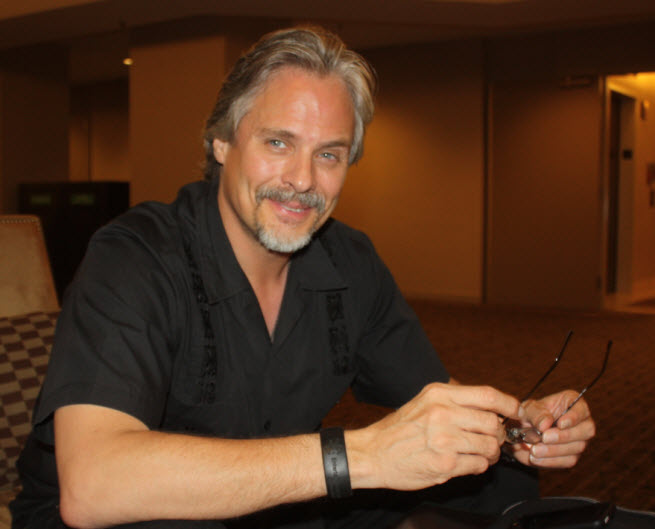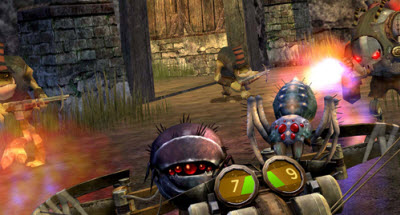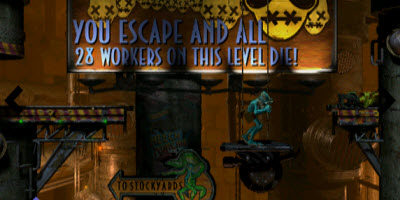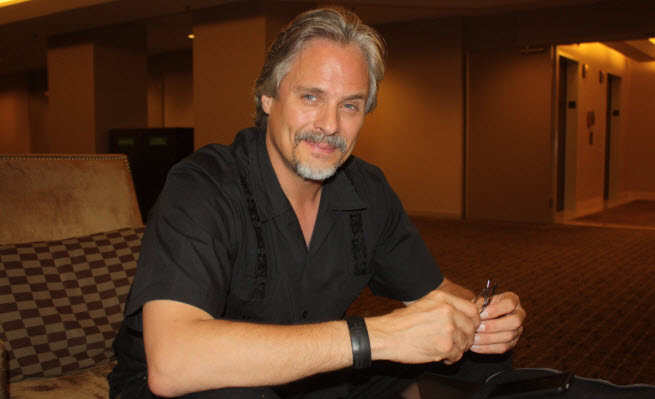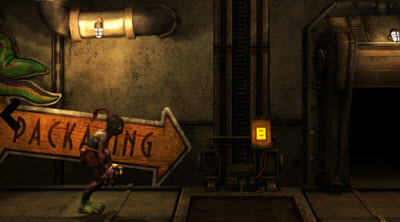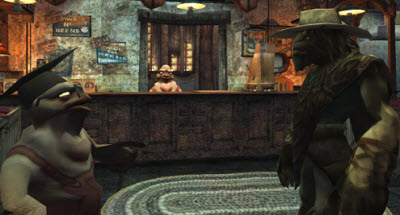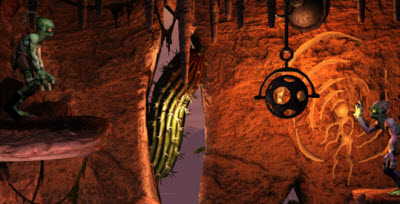Disclosure: The organizers of Siggraph paid part of my expenses to Anaheim, Calif. Our coverage remains objective.
Lorne Lanning, the founder of Oddworld Inhabitants, has been a fixture in the game industry for decades (and a loud one at that). Most recently, he was quoted as saying Microsoft didn’t care about indie game developers: “It’s as if we don’t matter.” Microsoft for its part, says it does care. This week, it coincidentally decided to announce that it does welcome indie developers on the next-generation Xbox One launching this fall. And it will make it so that anyone with an Xbox One console can develop and self-publish a game.
That suits Lanning better, but he is already moving down the road of publishing games on the Sony PlayStation 4, which is also launching this fall. His company’s Oddworld: New ‘n’ Tasty will be a high-definition remake of the 1997 game Oddworld: Abe’s Oddyssee. It will debut on the PlayStation. Then it will appear on other platforms including Nintendo’s Wii U and the PC. But it will not appear, so far, on the Xbox One.
Lanning said that he doesn’t miss the triple-A console days because he didn’t have control of his destiny — and he made just $7 on a $60 game. Today, he controls his own company on digital platforms and makes roughly, well, $7 on a $10 game. That’s not so bad. Having control matters, so he can tell anti-corporate tales like Oddworld: Abe’s Oddyssee or Oddworld: Stranger’s Wrath.
We caught up with Lanning at the Siggraph Business Symposium in Anaheim, Calif. Here’s an edited transcript of our conversation.
GamesBeat: What is your message about business and creativity?
Lorne Lanning: I want to address the chasm between creators and finance, why that chasm is increasing, and why there’s this renaissance upon us, where creators have alternatives to the traditional capitalistic model.
The ability to connect with the audience is changing all that. Digital distribution is changing the old paradigms. Now the old gold bears have to prove their value with more than just dollars. They have to come to the table with real value. It’s something I see a number of publishers having trouble doing – justifying their value. If creators can find an audience at a lower price, offer a product cheaper, and directly nurture that community, they don’t need the old guard anymore.
That takes us almost back to the typewriter days. I’m going to talk about Dr. Seuss and George Orwell, people who changed the world with a typewriter. We’re missing that in the industry today. We don’t have any Orwellian class of product, any Dr. Seuss integrity around his mission in life, which was basically to give kids a better compass for the heart. We’re missing that, for a lot of reasons. This is playing off that spectrum today for a brief while.
GamesBeat: You been annoyed by Microsoft’s policy, or lack of it, toward indie game companies.
Lanning: You maybe saw those headlines recently. “Lanning: Xbox One team should be fired over indie stance.” That was completely untrue. However, here’s what is true. I said there should be a mass firing, and that they should start with PR and marketing agencies. Not employees. Agencies.
This was before I think the real problem jumped ship. You wrote about that. I was surprised by the Don Mattrick article, because there was nothing about—How do you make a deal that quickly without having it pre-arranged while you were there at the show, selling your policies? Those were his policies. He’s the one who was reporting to Steve Ballmer. There was one guy who had the keys to the kingdom. So I looked at that and I thought, “How does that whole team feel, knowing that the guy who led them to that train wreck just jumped out with maybe a $5 million parachute?”
That’s an issue we don’t talk about today, because it’s not cool in capitalism to talk about that.
GamesBeat: And you like Nintendo’s way of doing things?
Lanning: Meanwhile, [Nintendo CEO] Satoru Iwata came out and said people were asking him, “When are you gonna lay off your development staff?”I don’t remember exactly what he said, but it was basically, “Laying off development is not going to solve our problems. Building great games is what we do and we’re going to continue doing it.” When he said that, in my opinion, he was immortalized in the creative community? I would work with him in a second. When a man in that type of position, in a world where the golden rule is the rule and that’s what’s expected at public companies, he stood up and said, “That’s not what we’re about. We’re about building great stuff. We have great people to build great stuff. We’re gonna do that.”
When I look at the history of Nintendo, I say, “Nintendo is gonna be here in 100 years.” I have no doubt. I doubt Microsoft will be here in 100 years. I know Zynga won’t be here in 100 years. I’ve been here longer than Zynga. [Laughs] We’re not making headlines in the Wall Street Journal, but we’re still building what we set out to build. Now we have to be clever and smaller in how we think, but we’re more self-empowered than we’ve ever been.
GamesBeat: Microsoft changed its message. They will allow self-publishing on the Xbox One. What do you think of it?
Lanning: Generally speaking, it’s a big shift in the right direction. Exactly what the details are, we’re still waiting to hear. As of now, MS has not specifically said how it’s all going to work. Every Xbox One as a dev kit is a very clever idea. How many hoops there are to self publishing, the clarity seems still to be had.
What we really want to know is, “Are we apples to apples with Sony and Steam policies, or is this a new orange?” Assuming that we’re apples to apples, this is smart for Xbox One, for its customers, and for the indie developer. By making the Xbox One audience accessible to indies, the indies potential sales are higher, which greatly increases their chances to survive another day. It would be a win-win for all sides.
GamesBeat: What are you guys conceiving or doing?
Lanning: As a company or as a loudmouth? [Laughs] As a company, I’d like to see Microsoft to pull it out. But the new person they put in charge, I don’t know much about her, but I think they’re bringing a lot of the traditional wisdoms of Microsoft back into the Xbox group. I don’t think that’s what made the Xbox in the first place. They reversed policies on the immediately obvious ones. I’m waiting for them to reverse on the self-published indies. If they don’t, we really don’t care about them. There’s no reason to. As we would say, offering no value.
A good capitalist would say—If I had VC partners, they would say, “You need to get in there and be selling on that network. If you need to do whatever to go do it, why aren’t you doing it?” As an independent, we just say, “We don’t have the resources to do whatever seems to be necessary. I can’t even tell what that is. And we don’t need to.” The VC space wants a 10X return. The publishers tend to want a 5X return. If you’re a 4X return you’re a loser. Whereas with our model now, if we get a 1.5X return, we’re still keeping people employed. We’re still able to seek growth. We’re still able to do what we’d like to do.
We’re able to grow in a very micro way. It’s not something that has investors that need to be appeased and that are really bringing no value beyond their cash. Usually that cash is what drives most of the pressure and most of the distractions. Being self-published and self-financed—It’s really crowd financing, because it’s revenue financing. The crowd is paying for it. They’re just not pre-paying for it. As a result, we’re able to do something different. We’re not having to approve our decisions past a board and institute their policies if they don’t agree. We can ask the audience what they would like to see. We’ve learned a tremendous amount that way.
GamesBeat: And you’ve learned what?
Lanning: What you learn is that if you involve the audience earlier, if you share with them and take in their feedback, they’re not looking for the perfect end product. They’re looking for companies they can engage with and believe in. They’re looking for a product that they like and they can feel closer to. They don’t need it delivered to them on the platinum platter. They want to feel as though they’ve been involved in its creation along the way.
That was a big wake-up call for me, because I was more cynical. I thought people did want that perfect tent-pole product, and if it wasn’t that, they’d rip you apart. When you’re playing in the triple-A retail space, they do.
Then we started polling them. Overnight, we had thousands of results back. We’d get surprises. The reason we’re making the game we’re making now is, with this dialogue and this discussion with our audience, we find that they would be very happy if we did something like that. Yes, they would like us to make a big new title with a big new story and fresh new characters, but if we aren’t able to do that, they would like us to revisit some of the old things and do them better, add new 21st-century dimensions to them. That’s what brought about New ‘n’ Tasty.
GamesBeat: How did you proceed?
Lanning: What’s interesting there is, the audience told us the product that they’d like to have. We then polled them again and held a sort of competition to name the title. We hired the biggest person in the fan community to manage the fan community. He’d been doing it for seven years and we weren’t even building a product. [Laughs] The mod community has been doing this for years with id, Epic, and Valve. People put out mods and the best of those mod-makers get hired. It’s a great thing, and we were never able to take advantage of it. But now, at least, through digital distribution, we’re able to connect with the audience and poll them. They are giving us back the answers that we’re looking for. Also, we’ll find out who’s creating really cool art.
It was an artist in the fan community that created these deco-style posters of every game we ever made. It was completely outside the design style of Oddworld, totally not Oddworld. It was Art Deco-ish 1930s style. We just loved them. I love when I see surprises in creations that other people are building on that I wouldn’t have thought of, that I wouldn’t have directed in that way. I really respond to that positively. It’s exciting to see that. So we hired that guy to design the new logo. He designed the New ‘n’ Tasty logo.
We always thought of Oddworld as more like a rock band, anyway. Rock bands don’t start with business plans. They just want to make cool stuff that they believe in. We were always more in that camp than having an intelligent exit strategy and all that. In embracing the community, this title was able to be shaped by the audience, to be named by the audience, to be branded by the audience, to be illustrated by the audience.
I even found this girl—She contacted me saying, “I want to do music for your games! I love your games! I had the Christmas cards when I was a little kid.” Her name is Elodie Adams, out of Australia. This voice is incredible. It was giving me chills. I would love to see that some of these people, through helping us, get more exposure on their own. In the indie model, it’s very easy to say, “Hey, we weren’t planning on licensing a song for our credits. We don’t really have anything in the budget. We’ll get you something. But we’d love to host links to whatever you’re selling.”
GamesBeat: How did all this lead you to the PS4 as opposed to Microsoft?
Lanning: Sorry. Didn’t mean to belabor that point. The PS4 was really a surprise. I think what led to that was, Sony did something incredible that we didn’t see coming. They created, on PS3 and PSN, backwards compatibility with PS1 titles. A number of people from back when we launched the original Abe game are still at Sony. Abe had a lot of support from Sony. We were never a first party, although often we were associated with them that way. They didn’t pay us anything. We were a third-party. But they were supportive because they had a culture of people who liked games and liked our game. A lot of those people continued to grow in the company.
As PSN became available, we started to realize, “Hey, we could put the Abe games up here.” We already had them on Steam, but it never occurred to me that we could do that. New hardware is always resistant to backwards compatibility because they want to show new software, show off those new chips. They don’t want the old library. That’s kind of like CD companies saying, “If it was on vinyl, we don’t want it on CD.” It’s kind of a catch-22 of chip-maximizing sensibilities. The audience, on the other hand, wants the biggest library with lots of choices. The music industry is the prime example of that. Just because a new piece of delivery technology comes out does not mean people don’t want to hear Elvis on all of that. The game industry was saying, “Sorry, no Elvis on our new CDs.”
That was a dilemma that I feel the industry had suffered through for many years with the console wars. We can go into the reasoning, but I still feel like the industry suffered because of it. It blew me away that PlayStation had started looking at it more like the way Apple handles the iTunes store, where it’s really about the music. Sony seemed to be saying, “It’s really about the games.”
GamesBeat: How does the new download business work?
Lanning: Well, we’re already on PC. The game had released on PC and PS1. For us, we’re self-investing. We placed the bet to not sell the company in 2005 and to not continue taking what I call “bad money.” Bad money was, like, Stranger money, where you’re going to do a lot more work for a lot less reward and a lot higher risk. This is not why we were creating games. We were just trying to figure out, “How can we afford to take what we do have, self-finance it onto various platforms, and get there?”
Steam was the first. Then we got onto other PC networks like GOG and some others around the world. But with the PSN, when we got our games up there, we didn’t have to really invest. Our games were already compatible. We were able to take our existing library and basically put it there. Then the sales from that allowed us to start to invest. Let’s convert Munch and Stranger and get them on the PSN. Let’s get them on PC, on Steam and GOG. Being out there, a $10 product was now returning $7 back to us. When we released those games at $60, let’s say we had a 20 percent royalty. After we earned back our entire development budget – when that 20 percent paid back all of the expenses – if that game was still $60 on the shelf, which it wouldn’t be, we would get that same $7 a unit.
This Christmas I was shocked to see it, but we were number one in the U.K. and Europe on Vita. That lasted for a few months. In the U.S. we were number two. That’s a game built in 2005.
GamesBeat: This let you make a comeback?
Lanning: What this micro-budgeting, self-financed approach also allowed us to do is look at each opportunity and care more about the people who would be engaged in the game, rather than how many units we could sell on the platform. When we built the Vita version, it was all about trying to make it as natively friendly as possible, taking advantage of what makes the Vita great. If we were at a big publisher, we wouldn’t have been able to do that. They would have said, “It’s not that many sales. It’s a small installed base. We shouldn’t be spending this much time and money on it.”
As a small group, we’re able to say, “We don’t know how big Vita is going to get, but we know that the people who bought those systems now are pretty passionate about it and they want great games that play great on those systems. So why don’t we do as well as we can to make it play as well as we can for gamers?” Not for investors, for gamers. If we do that, we think gamers will respond, and they did. It wasn’t like we were selling millions of units, because there wasn’t an installed base that big to sell to, but we were able to be in the charts again with very small budgets and a lot of passion.
All that led to the point where we could say, “We still can’t afford a $10 million product ourselves, but what can we do?”
I felt like we had a dilemma. We were exhausting the library, but we hadn’t made enough money to start financing those big titles.
GamesBeat: Then what did you do?
Lanning: This is where that dialogue with our audience led us to where I was telling you earlier. They said, “Redo Abe’s Oddysee like you redid Stranger.” We looked at it and said, “We want to get on the Unity platform anyway. We want to learn more about it. We think it’s going to be a powerful player in the future. It’s the indie platform. What if we do Abe’s Oddysee in 3D technology, with real lighting to make those environments come alive? What if we fix all the things that weren’t right about it and make it a better game?”
Watch all these movies that are being remade, like The Manchurian Candidate or The Time Machine. The list goes on. They’re never as good as the originals. We said, “What if we don’t try to rewrite it? What if we just redo that script, that game?” But instead of fixed-screen platforming, we have continuous side-scrolling. We don’t have pre-rendered bitmaps, we have realtime dynamic lighting. We just make that game as beautiful and as fluid and more fun than it ever was before. We fix the things that were wrong, add in difficulty settings, and other things we did with Stranger HD.
That’s what we’re building. Now we’re able to do that at a very low seven-figure level. But because we always have this long-term vision, from day one we were archiving everything. For Abe’s Oddysee, I had all those assets built virtually at film resolution. My heroes were George Lucas and Walt Disney. They were always all about archiving.
GamesBeat: You’re scheduled for 2014 with New ‘n’ Tasty?
Lanning: We will be on the PS 4 at or near launch. That was part of the exchange for being on stage. They said, “We’d love to have you on stage at E3, but we need at least a 30-day window on other platforms.” We’re like, “Are you kidding? That’d be priceless. Of course we’ll do it.”
Leading back to your question on PS4, the history of PSN and Oddworld and the successes that were happening there were kind of no-brainers. But really, it was Sony reaching out. I give a lot of this credit to Adam Boyes and Shuhei Yoshida and those minds driving things today. They were reaching out to creatives. I started getting invitations almost a year ago to show up at little secret hotel conferences where they were doing deep technical dives into the technology. Mark Cerny and some other people were talking about it.
I was in shock that I would even be invited on stage at E3. They made getting access to their development systems very easy. More important, the development system itself is remarkably developer-friendly.
GamesBeat: At this point in your road map, do you think you want to stay indie? Do you feel like you’re on a road going back to being more like a triple-A operation?
Lanning: I want to stay indie until I can afford triple-A.
GamesBeat: But is it possible just to stay indie for the rest of your life?
Lanning: I don’t see why not. Things can change. Terms can change on networks. But we’re looking more at the future than we are at the past, as far as the migratory patterns and how the environment is changing for all of us. Creators are connecting to their audience. As that happens, and as we basically eliminate the traditional distribution models, most of the money that the gamer is spending will come right back to the developer.
We’re thrilled about the 30 percent that we give to all our network partners that host us, the digital distribution sites. Wonderful! Take your 30 percent! Because we get 70 percent. That allows us to have cheaper price points. We’re on the shelf 24 hours a day. When we get a moment like being on stage with Sony, where they generously host us to speak to their cause, we’re up there with a little seven-figure title going against titles that people are spending $100 million on.
Back to my other point, I wouldn’t want to build $50 million titles. I wouldn’t mind building a $10 million title that’s very small and gets into the audience, and then we grow it into a $50 million title. But the idea of building something that big without building it alongside the audience as an ongoing player, that seems crazy today. There’s been a lot more learning from the social and free-to-play space. Not reading the script from there, but learning. Releasing smaller products, engaging an audience sooner, nurturing the audience, and investing over time.
GamesBeat: Does that mean crowdfunding?
Lanning: Crowdfunding is in our future. I’ve spent some time with Chris Roberts at Cloud Imperium to pick his brain on how he’s doing what he’s doing. We see that as the best model. Kickstarter is a way. What Cloud Imperium did is a much grander way. That may kick it into another category of financibility as well. We’ll see. It’s definitely in the plans.
VentureBeat's mission is to be a digital town square for technical decision-makers to gain knowledge about transformative enterprise technology and transact. Learn More
